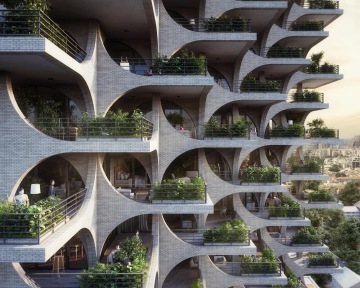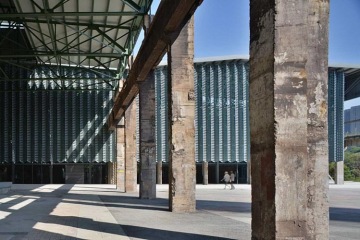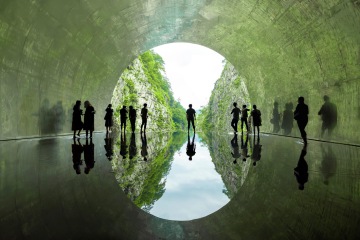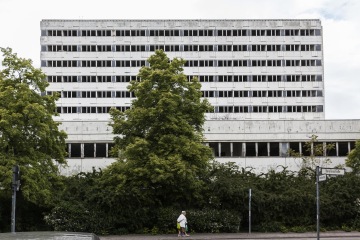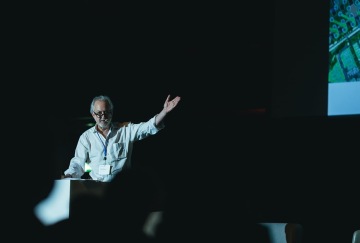
Remembering a Bright Urbanist Mind: Michael Sorkin
Late Michael Sorkin, the architectural critic, author, professor and designer, leaves behind his revolutionary approaches to urban design. We pay him a tribute in this look at how his legacy will continue to influence the field of urbanism for years to come. Photo courtesy of Dorota Velek at reSITE 2015.
By now you have most likely heard the news that author, critic, teacher, and designer Michael Sorkin passed away at the end of March. The digital urban planning world has been collectively mourning with outcries from peers like Michael Kimmelman, and profound headline's like "saw architecture as a vehicle for change" (The New York Times) and "championed social justice through architecture" (Washington Post). They weigh heavily, painting a picture of the larger-than-life impact he had on developing urbanist theories into palpable ideas available to a wider audience. We have spent some time thinking about Michael ourselves; we felt honored to host him at reSITE 2015 The Shared City and considered him a mentor, and a friend.
The architect and critic Michael Sorkin has died. I am heartbroken. This is a great loss. He was so many things. He was a supremely gifted, astute and acerbic writer. He wrote with moral force about big ideas and about the granular experience of life at the level of the street.1/
— Michael Kimmelman (@kimmelman) March 26, 2020
Michael Sorkin's legacy is that rare combination of urban planning genius concerned with the ordinary. His list of 250 things every architect should know whizzes in between knowing fear, your neighbors, how to spend time with five strangers in one room for six months (very apt for these pandemic times), what the planet can afford, and proportioning system for the Villa Rotonda. Sorkin's writing, criticism, speeches, and designs were at once practical and relevant, yet whimsical and poetic. His work was necessary.
Why Public Space Belongs to People with Michael Sorkin
Public space is not an entity, it's not a physical thing, so much as it is a series of negotiations.
Sorkin spent his life pushing us to reconsider the built environment around us and as things come to a halt because of life-threatening Covid-19, we've been given a moment to pause and reflect on Sorkin's legacy. It is imperative that we look around us and think about whether our buildings, cities, built environments and transport systems are truly serving us.
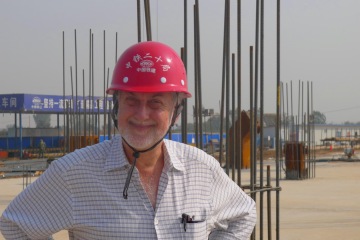
He was largely concerned with the role of public space in the city, understanding it simply as a pleasant place for people to gather. In his opinion, public space is not homogenous; it is a cluster of spaces where teenagers can skate alongside elderly people sitting on benches. He saw these shared spaces as a series of negotiations, of public and private interests. It is what the philosopher Marshall Berman called a “liquification of being” when encountering a wide array of people on the streets acts as an agent of your own change.
Fish are symmetrical but only until they wiggle. Our effort is to measure the space between the fish and the wiggle. This is the study of a lifetime.
Despite having a wide-ranging education—from Persian literature to urban design—Sorkin took care to look at and consider architecture and built environment like someone on the street, going about their daily life. He fervently criticized the luxury towers of New York, one example being his famed Village Voice attack from 1985: “Trump's third go at the world's tallest building...was there ever a man more preoccupied with getting it up in public?” He saw these constructions as flashy, lacking a public use and a social purpose. Sorkin's vision of a city is one in which architecture directly contributes to equality and sustainability and in which citizens can participate in this process.
One of Sorkin's greatest legacies is his singular focus on sustainability, long before it became a buzzword in marketing campaigns for seemingly everything. He founded Terreform, a non-profit architecture and urban design research consulting studio.
Michael Sorkin on Developing Urban Autonomy
In his (and by extension, Terreform's) view, cities and environments are seen as a network of connections between buildings, infrastructure, transportation (both public and personal), waste, food, water and energy. Connections permeate his philosophy - between humans, species, and environments. At reSITE 2015 The Shared City, Sorkin posed a question: “We need to create places that are sustainable, equitable and beautiful. But how?” His answer was a call to the negotiation of our role and relevance in built environments and the world.
He wrote with moral force about big ideas and about the granular experience of life at the level of the street.
It is not a stretch to say that we just lost one of the sharpest minds of architecture and urban theory. At reSITE, we can only hope we are able to implement some of his ideas about equality, inclusivity and sustainability in the future city. Sorkin´s gift to us was the accessibility of his ideas. Each one of us can revive a little of his spirit in our day to day lives. Looking at our street with a fresh pair of eyes, considering air quality and transport infrastructure in our neighbourhood, or simply being more critical and vocal about what is being built in our city centres. With his passing caused by, and coinciding with a worldwide health crisis, now is a better time than ever to make his ideas a stable pillar of how we build cities.

More Ideas from Brilliant Urbanist Minds
A New Generation of Architects with Chris Precht
Chris Precht’s aim to reconnect our lives to our food production by bringing it back into our cities and our minds can be found throughout his architecture. Listen as he discusses the importance of authenticity, creating spaces that activate our senses, and looking at our objective reality to solve the problems of our time.
Jee Liu on Applying Subtle Design to Adaptive Reuse
At the core of WallaceLiu’s projects is a design practice called adaptive reuse. In the age of the quest for sustainability, adaptive reuse is becoming more of a necessity for city-makers worldwide.
Yosuke Hayano on How Architecture Can Create Emotional Connections to Nature
Principal architect for MAD Architects, Yosuke Hayano says the studio strives to connect architecture to nature through the creation of emotional and spiritual spaces for everyday life.
Fighting Gentrification, Berlin-Style with Leona Lynen
A vast, unoccupied administration building in the heart of Berlin at Alexanderplatz - Haus der Statistik - has become a prototype for gentrification done right. Hear from Leona, a member of the cooperative, ZUsammenKUNFT, as she discusses how they are developing a mixed-use urban space oriented towards the common good. Photo courtesy of Nils Koenning
